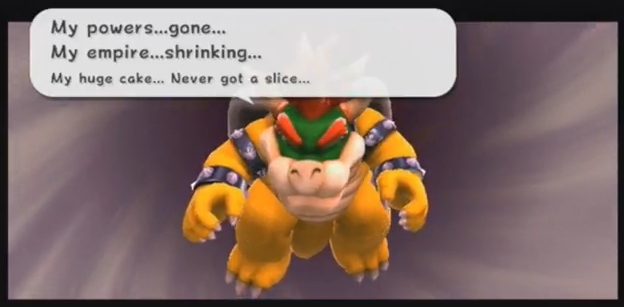 Ignoring everything I had said in the previous posts in this series about Commander Keen being next (stupid rat things still kill me…), I have instead worked my way though Crystal Caves.
Ignoring everything I had said in the previous posts in this series about Commander Keen being next (stupid rat things still kill me…), I have instead worked my way though Crystal Caves.
Like many other Apogee software games, this came in three episodes – Trouble with Twibbles, Slugging it Out and Mylo Versus the Supernova – with the first game being free and the other two requiring a purchase. An interesting fact I found out about these games was that a patch was released for the original game 14 years and one day after its original release, fixing a bug when run on Windows XP. That is what I call support!
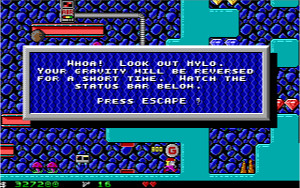 Meet our hero, Milo Steamwitz. He knows exactly how he is going to make his fortune, but needs to generate some money to invest first. So it is off to some remote planet where large crystals are just lying about in caves waiting to be harvested. You start off in some sort mine shaft that provides access to 16 caves to be explored. In each cave you have to run around, jumping between platforms, flicking switches on and collecting all the crystals while avoiding various obstacles and shooting aliens. Each cave has a bit of a theme to it, with some having continuously falling rocks to avoid and others having “low gravity” (which does not let you jump higher, but does mean you get forced back whenever you shoot – interesting…). Once all the crystals are collected, the exit door unlocks.
Meet our hero, Milo Steamwitz. He knows exactly how he is going to make his fortune, but needs to generate some money to invest first. So it is off to some remote planet where large crystals are just lying about in caves waiting to be harvested. You start off in some sort mine shaft that provides access to 16 caves to be explored. In each cave you have to run around, jumping between platforms, flicking switches on and collecting all the crystals while avoiding various obstacles and shooting aliens. Each cave has a bit of a theme to it, with some having continuously falling rocks to avoid and others having “low gravity” (which does not let you jump higher, but does mean you get forced back whenever you shoot – interesting…). Once all the crystals are collected, the exit door unlocks.
 I had played the first episode many times when I was younger so I zoomed through to the end quite quickly. For each level there is a key that you can collect which allows you to open all the treasure chests scattered throughout the level, but having no siblings around to eliminate from the high-score board, my motivation to do so was limited… At the end of the first episode, Milo sells up his collected crystals and invests in a Twibble farm. It turns out that Twibbles are prolific at eating and breeding so the planets resources are soon used up. Also, no-one wants to buy Twibbles any more, so I guess he just abandoned them all to die of starvation.
I had played the first episode many times when I was younger so I zoomed through to the end quite quickly. For each level there is a key that you can collect which allows you to open all the treasure chests scattered throughout the level, but having no siblings around to eliminate from the high-score board, my motivation to do so was limited… At the end of the first episode, Milo sells up his collected crystals and invests in a Twibble farm. It turns out that Twibbles are prolific at eating and breeding so the planets resources are soon used up. Also, no-one wants to buy Twibbles any more, so I guess he just abandoned them all to die of starvation.
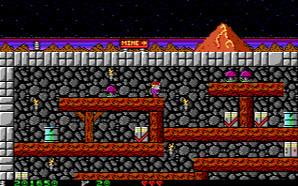 The second and third episodes are very similar to the first. I think there is a slight difficulty increase, but it is hard to judge given how much I had played the first episode previously. The difference I did notice was that a lot of levels required you to do the crystal collecting for different sections in a defined order. There were many places where the only way to go back to collect a crystal you missed was to die and restart the level. What is worse, there is a bug in the third game where in the mine shaft there is an area where you can not escape (pictured). So the two levels there must be left until last, otherwise you have to restart the game.
The second and third episodes are very similar to the first. I think there is a slight difficulty increase, but it is hard to judge given how much I had played the first episode previously. The difference I did notice was that a lot of levels required you to do the crystal collecting for different sections in a defined order. There were many places where the only way to go back to collect a crystal you missed was to die and restart the level. What is worse, there is a bug in the third game where in the mine shaft there is an area where you can not escape (pictured). So the two levels there must be left until last, otherwise you have to restart the game.
The second episode ends with Milo buying a slug farm. For some reason, everybody wants slugs and he is in danger of running out. But then the slugs burrowed underground to avoid the heat of the day and ended up in an old salt mine. So Milo’s profits quickly “dried up”. Oh, the hilarity…
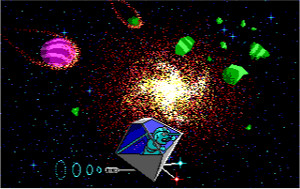 The final episode see Milo giving up on farming. Instead he wants to buy a solar system to set up a vacation resort based on some perfectly legitimate sounding scheme he saw on TV. Sure enough, once he signs the contract, the whole solar system gets destroyed in a supernova (I bet you could have never guessed that would happen from the game title…). Luckily, the supernova left a nice looking backdrop for a space burger joint. It is now quite popular and Milo can sell his burgers at a price that looks expensive even accounting for inflation.
The final episode see Milo giving up on farming. Instead he wants to buy a solar system to set up a vacation resort based on some perfectly legitimate sounding scheme he saw on TV. Sure enough, once he signs the contract, the whole solar system gets destroyed in a supernova (I bet you could have never guessed that would happen from the game title…). Luckily, the supernova left a nice looking backdrop for a space burger joint. It is now quite popular and Milo can sell his burgers at a price that looks expensive even accounting for inflation.
I was slightly disappointed at the lack of additional game-play elements in the second and third episodes. The two episodes I had not previously played were entertaining enough, but that is influenced by nostalgia. Overall, I think these games are worth playing, but if you finish the free episode and are not impressed, do not think things will improve.
So… will I finish Commander Keen: Vorticons for the next post? Not likely… But I am running out of ideas for old DOS games to play, so make me some suggestions.
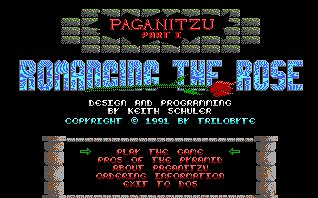 Welcome back to the ongoing series of posts about my adventures in playing old games from my childhood. I know that in
Welcome back to the ongoing series of posts about my adventures in playing old games from my childhood. I know that in  Onto the actual game. Our hero is famous archaeologist and part time treasure hunter Alabama “Al” Smith, a character not too subtly modelled after Indiana Jones. Unfortunately of late his fame has been slipping with people like Bart Simpson and Oprah Winfrey taking his spotlight. So Al studies his ancient texts and finds reference to an ancient pyramid called Paganitzu, meaning “Temple of the Gods”. Rumoured to be inside this pyramid are objects of great power including the Crystal Rose, a jeweled flower that will bring peace to the man who holds it, and the Silver Dagger, which gives the strength of the gods to it wielder. So off to remote southern Mexico where Al finds a grassy hill in an otherwise flat area. Sure enough, this is the temple he is looking for and there is the entrance…
Onto the actual game. Our hero is famous archaeologist and part time treasure hunter Alabama “Al” Smith, a character not too subtly modelled after Indiana Jones. Unfortunately of late his fame has been slipping with people like Bart Simpson and Oprah Winfrey taking his spotlight. So Al studies his ancient texts and finds reference to an ancient pyramid called Paganitzu, meaning “Temple of the Gods”. Rumoured to be inside this pyramid are objects of great power including the Crystal Rose, a jeweled flower that will bring peace to the man who holds it, and the Silver Dagger, which gives the strength of the gods to it wielder. So off to remote southern Mexico where Al finds a grassy hill in an otherwise flat area. Sure enough, this is the temple he is looking for and there is the entrance…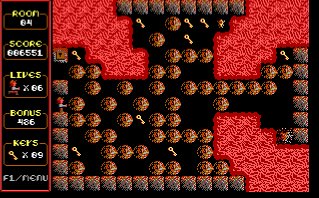 Releasing evil gods is usually not a good thing and Omigosh is no exception. He travels deeper into the pyramid and plans to raise an army of undead to destroy the world. Understandably, Al feels a bit guilty about causing impending destruction and decides to go find the Silver Dagger in the aptly named “Part 2: Quest for the Silver Dagger”. While the overall style of the game remains the same, as we delve deeper into the pyramid it has now become hot and lava filled. Along with a selection of new monsters, this gives quite a different feel to part two of the game. The strategies required for solving the puzzles also shift to quite an extent with this change to make the puzzle solving a challenge again.
Releasing evil gods is usually not a good thing and Omigosh is no exception. He travels deeper into the pyramid and plans to raise an army of undead to destroy the world. Understandably, Al feels a bit guilty about causing impending destruction and decides to go find the Silver Dagger in the aptly named “Part 2: Quest for the Silver Dagger”. While the overall style of the game remains the same, as we delve deeper into the pyramid it has now become hot and lava filled. Along with a selection of new monsters, this gives quite a different feel to part two of the game. The strategies required for solving the puzzles also shift to quite an extent with this change to make the puzzle solving a challenge again.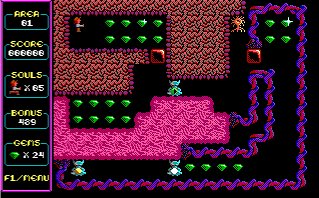 Little things like being a ghost are not going to stop our hero. In fact, now he is already dead, travelling back in time does not seem such a bad idea… So onward to “Part 3: Jewel of the Yucatan”. The first thing Al notices is that the pyramid as seen by the dead is a living entity with walls made out of a quivering biomass. This makes for a third style to the games levels, which, along with the addition of some new deadly creatures (ghosts are not immune to being attacked) and new puzzle elements, changes the style of game play yet again. I am not sure if I was just doing the levels in novel ways, but I found there was a lot more usage of moving enemies to block other enemies and having to time movements precisely, bringing more of an action feel to the final part. Another twenty levels and we make it back to the Skull Oracle. Why were you now twenty levels away from the Skull Oracle when you only travelled ten levels away in Part 2? These are the mysteries of the pyramid that are not meant to be solved by the likes of us…
Little things like being a ghost are not going to stop our hero. In fact, now he is already dead, travelling back in time does not seem such a bad idea… So onward to “Part 3: Jewel of the Yucatan”. The first thing Al notices is that the pyramid as seen by the dead is a living entity with walls made out of a quivering biomass. This makes for a third style to the games levels, which, along with the addition of some new deadly creatures (ghosts are not immune to being attacked) and new puzzle elements, changes the style of game play yet again. I am not sure if I was just doing the levels in novel ways, but I found there was a lot more usage of moving enemies to block other enemies and having to time movements precisely, bringing more of an action feel to the final part. Another twenty levels and we make it back to the Skull Oracle. Why were you now twenty levels away from the Skull Oracle when you only travelled ten levels away in Part 2? These are the mysteries of the pyramid that are not meant to be solved by the likes of us…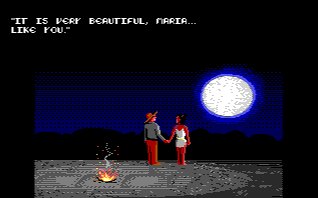 The final episode finishes with a stunning two hour cinematic! OK… it is apparently only 17 minutes long but it certainly takes a while to sit and watch. The Skull Oracle sends our hero back in time 500 years to get the magician Debasco to come save the world. Debasco is nice enough to restore Al back to life and so Al rewards him by getting it on with his daughter Maria, coincidentally being the woman whose body Omigosh inhabits in the future. Unfortunately, Debasco can only take one person with him to the future and that must be Al (or he could affect the space-time continuum), so his daughter gets left behind to be brutally murdered by the invading Spaniards (seriously, that is almost word for word…). Back in the future, the battle between Debasco and Omigosh looks helpless, until somehow the spirit of Maria banishes Omigosh from her body and Debasco can take him to the firely pits of hell. Al and Maria celebrate the vanquishing of Omigosh (seemingly ignoring the fact her father died…) and walk off into the sunset. You would think that 500 years of decay would be off-putting for a man, but you have to Al credit. As an archaeologist, I guess he likes old things…
The final episode finishes with a stunning two hour cinematic! OK… it is apparently only 17 minutes long but it certainly takes a while to sit and watch. The Skull Oracle sends our hero back in time 500 years to get the magician Debasco to come save the world. Debasco is nice enough to restore Al back to life and so Al rewards him by getting it on with his daughter Maria, coincidentally being the woman whose body Omigosh inhabits in the future. Unfortunately, Debasco can only take one person with him to the future and that must be Al (or he could affect the space-time continuum), so his daughter gets left behind to be brutally murdered by the invading Spaniards (seriously, that is almost word for word…). Back in the future, the battle between Debasco and Omigosh looks helpless, until somehow the spirit of Maria banishes Omigosh from her body and Debasco can take him to the firely pits of hell. Al and Maria celebrate the vanquishing of Omigosh (seemingly ignoring the fact her father died…) and walk off into the sunset. You would think that 500 years of decay would be off-putting for a man, but you have to Al credit. As an archaeologist, I guess he likes old things… The recent release of Duke Nukem Forever got me thinking back to the original game and how many hours I sunk into as a child. (If you are thinking I mean Duke Nukem 3D, I shake my fist at you and yell “Get of my lawn”!) As with many games at the time, I only had the shareware version and not the complete game. So I decided it was time to relive my youth and obtain a copy of the complete game. Time to crank up
The recent release of Duke Nukem Forever got me thinking back to the original game and how many hours I sunk into as a child. (If you are thinking I mean Duke Nukem 3D, I shake my fist at you and yell “Get of my lawn”!) As with many games at the time, I only had the shareware version and not the complete game. So I decided it was time to relive my youth and obtain a copy of the complete game. Time to crank up  Given how many times I had played through the first episode in my youth, it took me about a hour to race through and finish it. I still took some time out to explore some levels and relive the excitement of going to those very easy to find secret rooms. I still do not understand how Duke decides how often he can pull the trigger. It is not a function of reload time as if you hit something close range, you can immediately fire again. But miss and you will need to wait until the bullet goes out of the screen… Strange they had not sorted such things out in the future that is 1997, but you eventually upgrade your pistol and are allowed to fire four shots at once which is more than enough. Another thing that concerned me is the shooting of a turkey leg turns it into an entire turkey which Duke then eats for double health recovery. I would have thought eating food shoot with a nuclear pistol was not recommended…
Given how many times I had played through the first episode in my youth, it took me about a hour to race through and finish it. I still took some time out to explore some levels and relive the excitement of going to those very easy to find secret rooms. I still do not understand how Duke decides how often he can pull the trigger. It is not a function of reload time as if you hit something close range, you can immediately fire again. But miss and you will need to wait until the bullet goes out of the screen… Strange they had not sorted such things out in the future that is 1997, but you eventually upgrade your pistol and are allowed to fire four shots at once which is more than enough. Another thing that concerned me is the shooting of a turkey leg turns it into an entire turkey which Duke then eats for double health recovery. I would have thought eating food shoot with a nuclear pistol was not recommended… Anyway, moving on to Episodes 2 and 3 that I had not played before. There is nothing new in game play in these episodes, only slightly different scenery. In Episode Two: “Mission: Moonbase” (yes, multiple colons in the title), Duke follows Dr. Proton to his moonbase using his time transport machine. That is right… time transport to get to the moon. The second episode was rather non-challenging – I died once for the entire game. You get pistol upgrades all over the place so enemies are readily defeated. I found more than the three you need to fully upgrade your pistol and I hardly explored everywhere. I was also slightly surprised the “Super Jump Boots” were not given in an early level given we are on the moon. The only real challenge was the level designer was obviously bored with having nothing new to work with, so just made larger mazes and put more bad guys everywhere. That does not so much increase the difficulty but rather just makes the game longer. Only on one level was the path to take in the maze not particularly obvious. A little more than two hours of game play and I had beaten Dr. Proton again. That boss battle was also poorly programmed as I noticed Dr. Proton flies up and down in the room in front of you and you can just stand back and shoot without going near him. I was far too manly to do that and attacked the good old fashioned way and just ran in guns blazing.
Anyway, moving on to Episodes 2 and 3 that I had not played before. There is nothing new in game play in these episodes, only slightly different scenery. In Episode Two: “Mission: Moonbase” (yes, multiple colons in the title), Duke follows Dr. Proton to his moonbase using his time transport machine. That is right… time transport to get to the moon. The second episode was rather non-challenging – I died once for the entire game. You get pistol upgrades all over the place so enemies are readily defeated. I found more than the three you need to fully upgrade your pistol and I hardly explored everywhere. I was also slightly surprised the “Super Jump Boots” were not given in an early level given we are on the moon. The only real challenge was the level designer was obviously bored with having nothing new to work with, so just made larger mazes and put more bad guys everywhere. That does not so much increase the difficulty but rather just makes the game longer. Only on one level was the path to take in the maze not particularly obvious. A little more than two hours of game play and I had beaten Dr. Proton again. That boss battle was also poorly programmed as I noticed Dr. Proton flies up and down in the room in front of you and you can just stand back and shoot without going near him. I was far too manly to do that and attacked the good old fashioned way and just ran in guns blazing.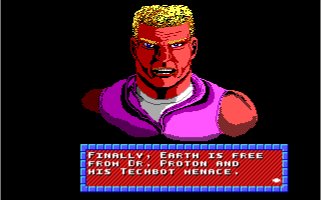 Episode Three: “Trapped in the Future!” sees Dr. Proton escape to the future in his time machine. Duke immediately follows without so much as a short rest even though he would much rather watch Opera. He is obviously not the brightest guy… he could assumably still watch Opera and then go to the point in the future where he was needed at his leisure. Again, nothing much changed in the third episode. The mazes got more annoying (when you start right beside a keycard access point, you know you are going to have to walk all the way back once you collect the key…). The main difference was that in the future there seems to be some horrid green colour to everything and so some levels are hard to look at. Also, random spikes are put everywhere on the ground so when you jump or drop down blindly to the next platform, you are going to take damage. No way to avoid that either as you can not take a look around slightly off screen before jumping there. This episode also appeared to be much shorter to me. I did try exploring most places, but obviously I was not very thorough as when I (very unexpectedly) arrived at the final fight with Dr. Proton, I did not have a fully powered up pistol. I did die a couple of times on the final fight, so there was some increase of difficulty. Although both of those were due to shear surprise that as soon as you drop into the final room you are being blasted by some flame and the boss is right above you and there are spikes everywhere you look to hide. As soon as I realized I just needed to get to the other side of the room, turn and shoot, Dr. Proton was soundly defeated.
Episode Three: “Trapped in the Future!” sees Dr. Proton escape to the future in his time machine. Duke immediately follows without so much as a short rest even though he would much rather watch Opera. He is obviously not the brightest guy… he could assumably still watch Opera and then go to the point in the future where he was needed at his leisure. Again, nothing much changed in the third episode. The mazes got more annoying (when you start right beside a keycard access point, you know you are going to have to walk all the way back once you collect the key…). The main difference was that in the future there seems to be some horrid green colour to everything and so some levels are hard to look at. Also, random spikes are put everywhere on the ground so when you jump or drop down blindly to the next platform, you are going to take damage. No way to avoid that either as you can not take a look around slightly off screen before jumping there. This episode also appeared to be much shorter to me. I did try exploring most places, but obviously I was not very thorough as when I (very unexpectedly) arrived at the final fight with Dr. Proton, I did not have a fully powered up pistol. I did die a couple of times on the final fight, so there was some increase of difficulty. Although both of those were due to shear surprise that as soon as you drop into the final room you are being blasted by some flame and the boss is right above you and there are spikes everywhere you look to hide. As soon as I realized I just needed to get to the other side of the room, turn and shoot, Dr. Proton was soundly defeated.